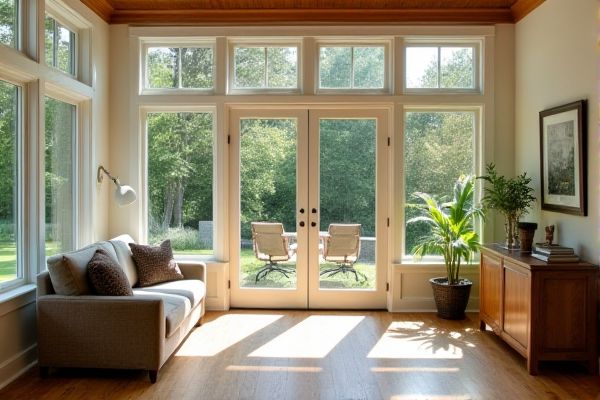
Casement windows provide superior ventilation and unobstructed views, while sliding windows offer ease of operation and a streamlined appearance for your sunroom. Discover which window type best suits your sunroom design by reading on.
Table of Comparison
| Feature | Casement Windows | Sliding Windows |
|---|---|---|
| Operation | Hinged, swings outward | Glides horizontally on track |
| Ventilation | Excellent airflow, full open | Moderate airflow, half open |
| Energy Efficiency | Tight seal, high efficiency | Good seal, moderate efficiency |
| Maintenance | More moving parts, periodic lubrication | Fewer moving parts, easy cleaning |
| Space Impact | Requires exterior clearance | No exterior space needed |
| Cost | Typically higher price | Generally cost-effective |
| Aesthetic | Classic, elegant appearance | Modern, streamlined look |
Introduction to Sunroom Window Choices
Choosing between casement windows and sliding windows for your sunroom involves considering factors like ventilation, ease of use, and aesthetic appeal. Casement windows provide superior airflow and unobstructed views due to their outward swing design, while sliding windows offer a sleek, space-saving mechanism ideal for contemporary sunroom layouts. Your selection impacts natural light, energy efficiency, and overall comfort, making it crucial to weigh these window types against your sunroom's specific needs.
Casement vs Sliding Windows: Key Differences
Casement windows feature a hinged design that opens outward, providing superior ventilation and unobstructed views in your sunroom, while sliding windows glide horizontally, offering ease of use and space-saving benefits. Casement windows seal tightly when closed, enhancing energy efficiency and weather resistance, whereas sliding windows may allow more air infiltration but excel in low-maintenance operation. Choosing between casement vs sliding windows depends on priorities like airflow, view, and ease of cleaning to optimize your sunroom's comfort and functionality.
Energy Efficiency Comparison
Casement windows in sunrooms provide superior energy efficiency by creating a tight seal when closed, preventing air leaks and reducing heat loss compared to sliding windows, which often have gaps that allow drafts. Your sunroom can maintain a more consistent temperature with casement windows, lowering heating and cooling costs over time. Sliding windows offer convenience but generally fall short in energy performance, making casement windows the better choice for energy-conscious homeowners.
Ventilation and Airflow Performance
Casement windows in sunrooms provide superior ventilation and airflow performance by fully opening outward, allowing maximum fresh air intake and enhanced cross-ventilation. In contrast, sliding windows offer limited airflow since only half of the window can be opened at a time. Optimal sunroom ventilation is achieved with casement windows due to their unobstructed opening design, promoting better air circulation and indoor comfort.
Aesthetics and Visual Appeal
Casement windows offer a classic, elegant look with their sleek, hinged design that enhances the architectural style of any sunroom. Sliding windows provide a modern, streamlined appearance and maximize unobstructed views with their large glass panes. Both window types contribute unique visual appeal, with casements emphasizing traditional charm and sliders promoting contemporary openness.
Ease of Operation and Accessibility
Casement windows in sunrooms offer superior ease of operation with a crank mechanism that allows for smooth, full ventilation control even in tight spaces. Sliding windows provide straightforward accessibility by gliding horizontally within the frame, making them ideal for areas where outward clearance is limited. Both window types enhance natural airflow, but casement windows generally require less physical effort to open fully compared to sliding windows.
Cleaning and Maintenance Factors
Casement windows in sunrooms offer easier cleaning due to their ability to swing outward, providing full access to both sides of the glass. Sliding windows require more frequent track maintenance to prevent dirt buildup and ensure smooth operation. Your choice should consider how much effort you're willing to invest in regular cleaning and upkeep for optimal performance.
Security and Safety Considerations
Casement windows in sunrooms offer enhanced security with multi-point locking systems that engage tightly against the frame, making them harder to force open compared to sliding windows. Sliding windows, while convenient for ventilation, often have single-track locks that may be more vulnerable to break-ins without additional security measures such as security bars or advanced locks. Your choice impacts the overall safety of the sunroom, with casement windows providing a more secure barrier against intruders and better protection from external elements.
Cost and Installation Aspects
Casement windows typically cost more than sliding windows due to their complex hardware and hinges, requiring professional installation for proper sealing and operation. Sliding windows offer a more budget-friendly option with straightforward installation that often reduces labor costs and time. Choosing your sunroom's window style depends on balancing initial budget constraints with long-term durability and maintenance preferences.
Which Window Style Is Best for Your Sunroom?
Casement windows provide superior ventilation and unobstructed views, making them ideal for sunrooms where fresh air and natural light are priorities, while sliding windows offer easy operation and space-saving benefits perfect for areas with limited exterior clearance. Your choice depends on whether you value maximum airflow and aesthetic appeal or practicality and compact design. Evaluating your sunroom's layout and how you intend to use the space will help determine which window style best suits your needs.
 homyna.com
homyna.com